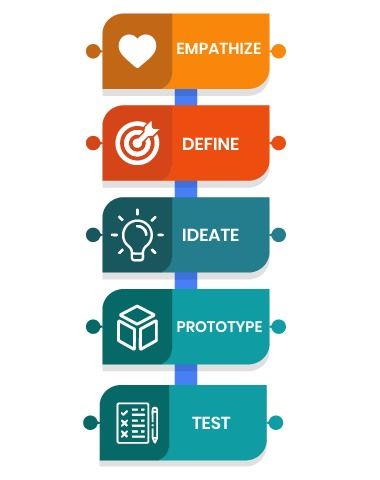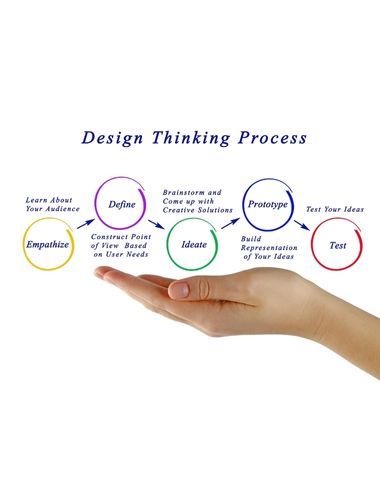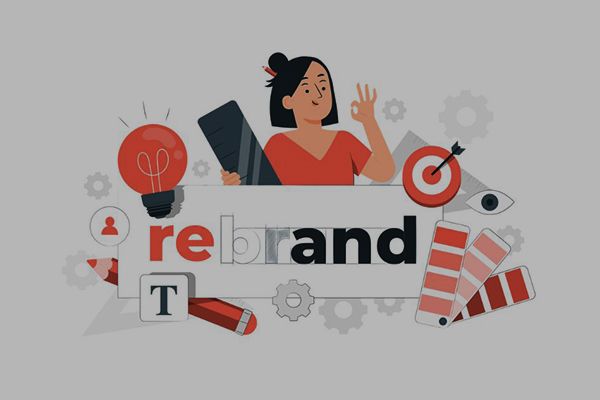5 Stages in the Design Thinking Process
Design Thinking is more than just a buzzword; it’s a human-centered approach to innovation, creativity, and problem-solving. Popularized by IDEO and Stanford’s d.school, this framework helps teams design with empathy rather than assumptions.
At its core, Design Thinking focuses on understanding real human needs, defining meaningful challenges, and building effective, tested solutions.
Whether you’re improving a product, service, or business process, Design Thinking provides a flexible framework for transforming insights into meaningful impact. By combining user experience, business innovation, and collaboration, it guides teams from understanding problems deeply to creating solutions that truly work.
There are five different stages in the Design Thinking Process. On this blog, we will look into them one by one.

Stage 1: Empathize: Understand Your Users’ Needs
The first stage is all about empathy, getting close to your users and developing deep emotional insight into their pain points, motivations, and experiences.
In this phase of user research, designers gather qualitative data to understand what users need and why they behave in a certain way.
Purpose
To build genuine empathy and understand your users’ context, their thoughts, feelings, and frustrations before defining any solutions.
Techniques
- User interviews: uncover real needs, fears, and goals.
- Journey mapping: visualize the complete user experience.
- Observation: study real interactions and behaviors.
- Empathy maps: capture what users say, think, feel, and do to build a complete emotional picture.
By connecting emotionally with users, teams move beyond assumptions and gain the insights needed for impactful innovation.
Stage 2: Define: Frame the Problem Clearly
Once research is complete, it’s time to synthesize insights into a clear problem definition. This is where problem framing transforms scattered information into a meaningful direction.
Purpose
To clearly articulate the core user challenge and craft a problem statement (or point of view) that guides the rest of the process.
Techniques
• Review research and identify recurring patterns.
• Create user personas that represent distinct audience types.
• Write a focused problem statement
For example, look at the sentence below.
“Frequent travelers need a trustworthy booking platform that reflects real quality because they often feel uncertain about what they’re getting.”
Through insight synthesis and clear framing, teams align on the right design challenge, ensuring they solve problems that truly matter.
Stage 3: Ideate: Generate Creative Solutions
With a well-defined problem, the next step is creative ideation, exploring as many ideas as possible before narrowing them down.
Purpose
To encourage divergent thinking, unlock innovation through open, collaborative exploration.
Techniques
• Brainstorming sessions to spark bold, unexpected ideas.
• Mind mapping to visually connect related thoughts.
• Use “How Might We” questions to reframe challenges creatively:
One of the examples can be thinking about “How might we make the booking process feel effortless and exciting?”
Ideation is about quantity and creativity; no idea is too wild. The goal is to create an innovation workshop environment where imagination meets possibility.
By promoting brainstorming methods that value openness and collaboration, teams generate ideas that go beyond predictable solutions.
Stage 4: Prototype: Turn Ideas into Tangible Models
Now, it’s time to bring your best ideas to life through prototyping, transforming abstract concepts into tangible representations.
Purpose
To create early, testable models or mockups that allow you to experiment and learn quickly.
Types of Prototypes
• Low-fidelity: paper sketches, storyboards, or digital wireframes.
• High-fidelity: detailed mockups or early-stage MVPs (Minimum Viable Products).
Prototypes make ideas visible, enabling rapid validation through real user feedback. This iterative, hands-on approach reduces risk while strengthening creativity.
By experimenting early, you save time, learn faster, and create designs that are practical and user-centered.
Stage 5: Test: Validate and Refine Solutions
Testing brings everything together. This stage focuses on usability testing, feedback loops, and continuous iteration.
Purpose
To validate ideas with real users, understand what works, and refine prototypes to improve usability and effectiveness.
Technique
• Conduct user testing sessions to observe how people interact with your design.
• Gather feedback and note common friction points.
• Refine the solution, returning to earlier stages when necessary.
The testing phase reinforces the non-linear nature of Design Thinking — it’s an ongoing feedback cycle that helps teams refine ideas until they truly meet user needs.
Principles of Design Thinking
Every stage of Design Thinking is grounded in timeless principles that define a design mindset and creative confidence:
• Human-centeredness: Empathy drives every decision.
• Collaboration: Multidisciplinary teamwork fosters stronger ideas.
• Iteration: Refinement through testing ensures progress.
• Experimentation: Bold exploration fuels innovation.
• Empathy: The heart of all user-centric design.
By practicing these principles, teams develop a user-centric and mobile-friendly design that transforms creativity into meaningful impact.
Importance of the Design Thinking Process
Innovation and Problem-Solving
Design Thinking drives organizational innovation by encouraging solutions built on empathy and user insights, not guesswork.
Teamwork and Collaboration
Its agile mindset breaks silos and promotes shared ownership from UX designers to business strategists.
Competitive Advantage
Companies that adopt a human-centered innovation model see measurable improvements in customer satisfaction, loyalty, and long-term differentiation.
This business transformation mindset keeps organizations flexible, curious, and user-focused.
In Which Stage of Design Thinking Do You Build a Representation?
The Prototype stage is where ideas become visual or physical representations. This is where experimentation, iteration, and tangible modeling begin.
From simple sketches to interactive mockups, prototypes help teams visualize solutions and refine them based on real feedback, turning ideas into reality one iteration at a time.
Did You Know Design Thinking Is a Non-Linear Process?

Although often shown as a sequence, the Design Thinking workflow is iterative and flexible. Teams frequently loop back, empathizing again, redefining challenges, or re-testing solutions.
This non-linear process allows innovation to evolve naturally through feedback cycles and continuous learning.
By embracing this iterative workflow, organizations foster adaptability, a vital skill in modern UX design and business innovation.
Final Thoughts
The Design Thinking process isn’t just a design framework; it’s a mindset for innovation that blends creativity, empathy, and experimentation.
Whether you’re in UX design, business strategy, or education, applying these principles helps solve problems more meaningfully and effectively.
Start small: talk to your users, map their journeys, test your ideas early, and keep iterating. The best designs don’t come from assumptions; they come from understanding humans deeply and designing with heart.
Our Expertise
Technology
-
Website Design and Development
Fully custom designed website
specifically curated for your
business. -
Web app development
Secure, reliable web portals that attract and engage customers -
Mobile app development
To keep up with on-the-go, mobilecentric consumers
-
Progressive web app development
Cost-effective web-based mobile application solutions that can operate in offline environments -
UI/UX design for website, web application & mobile apps
Curating seamless, intuitive experiences for application users -
Software development
Conceptualizing and creating innovative solutions that cater to your business
-
API development
Tools that help you connect and communicate across systems and other applications -
Comprehensive support & maintenance
Ongoing support from our full team of tech wizards for you websites -
Server hosting & support
Server setup, Monitoring and maintenance - one less thing for you to worry about
Technologies we use for development:


Art & Design
-
Logo
-
Graphics
-
Art
-
Sketch
Communication & Marketing
-
Content Development
(content writing, photography and videography)
-
SEO
-
Graphics
-
Social Media
-
E-newsletter
-
Workshop
(Branding & Strategic Communication)




